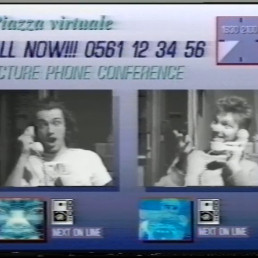Coffeehouse
(Women’s Coffeehouse / Gay Coffeehouse)
No other format was on the program more often at Piazza virtuale than “Coffeehouse”. The program came closest to the concept of a “self-generating show” that Piazza virtuale was based on, since viewers could get involved by calling in, faxing in or sending a voicemail. Just like in a Viennese coffee house, the idea was to create an informal conversational situation with chance acquaintances.
It was this show that earned Pizza virtuale the derisive nickname “Hello TV”. Many callers only said “Hello”. Some of them were so surprised or frightened that they were on TV that they hung up right away. Those who stayed on the line had only five minutes to find a topic of conversation with other callers before their connection was terminated in favor of new callers. A 3Sat employee made sure that no insults, political extremism, advertising, or pornography made it into the program, a practice known as “content moderation” on contemporary social media, but still known simply as “censorship” on Van Gogh TV.
There were no length limits in the programs that aired on the Olympus television satellite, and so more detailed and personal conversations occurred there more often. A group of regular callers eventually even came to Kassel to meet the makers of Van Gogh TV and each other in person – an example of a “virtual community” that developed as a result of the broadcast.
Video clip of Coffeehouse
Screen shots of Coffeehouse
Documents
Various stages in the development of the “Coffeehouse” design: from a storyboard by Gérard Couty (left) to two static computer sketches and two drafts from video material created during the preparation of “Piazza virtuale”. The black-and-white design comes from an advertising folder for sponsors, which is possibly where the slogan “Come Together” of the West cigarette brand at the time comes from, along with the logo in the sketch.








